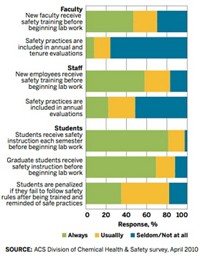Advertisement
Grab your lab coat. Let's get started
Welcome!
Welcome!
Create an account below to get 6 C&EN articles per month, receive newsletters and more - all free.
It seems this is your first time logging in online. Please enter the following information to continue.
As an ACS member you automatically get access to this site. All we need is few more details to create your reading experience.
Not you? Sign in with a different account.
Not you? Sign in with a different account.
ERROR 1
ERROR 1
ERROR 2
ERROR 2
ERROR 2
ERROR 2
ERROR 2
Password and Confirm password must match.
If you have an ACS member number, please enter it here so we can link this account to your membership. (optional)
ERROR 2
ACS values your privacy. By submitting your information, you are gaining access to C&EN and subscribing to our weekly newsletter. We use the information you provide to make your reading experience better, and we will never sell your data to third party members.
Safety
Using Accidents To Educate
Accidents can teach valuable lessons, if only they are heeded
by Sophie L. Rovner
April 30, 2007
| A version of this story appeared in
Volume 85, Issue 18

"WHEN AN EMPLOYEE reports to his supervisor that his face is red and blistering after he walked through a research center, how do you determine the cause?" That was the question posed by Thomas O. Murdock, environmental health and safety director at Medtronic, during last month's American Chemical Society national meeting in Chicago. Murdock described the incident that prompted this question during a Division of Chemical Health & Safety symposium about teaching safety. Other speakers included Robert H. Hill Jr., of Battelle Memorial Institute, who said that lab personnel must pay closer attention to the lessons that can be learned from accidents, or they will be condemned to repeat those accidents.
The incident at Medtronic, a medical device company, occurred last fall at the firm's headquarters site in Minneapolis, Murdock said. On a Saturday morning, a security guard making his rounds went through the technology center, the only building of the four at the site that contains labs. Researchers at the facility conduct R&D on specialty polymers, surface modification, surface analysis, and biosciences, all geared toward augmenting the biocompatibility of Medtronic devices.
A half hour after the guard left the building, "he complained to his supervisor that he had a rash on his face and hands," Murdock said. The company alerted the fire department, which dispatched an ambulance and contacted one of Minnesota's chemical assessment teams.
The incident was initially treated as if it were the result of a chemical exposure, said Murdock, who is also a member of the assessment team. "The fire department decontaminated the security guard, and he was transported to a local hospital. He was given an antihistamine, and he recovered 100%."
But that's not the end of the tale, Murdock said. "The real story is how it took the agencies that responded—the fire department, the chemical assessment team, the hazard medics from the ambulance, and myself—about four hours to figure out that whatever made him sick was not the result of a chemical exposure." The culprit? It turns out the security guard had a previously undiagnosed allergy to peanuts, which he'd eaten before entering the lab.
Medtronic learned several lessons and has instituted some changes as a result of the experience. For instance, when the incident occurred, emergency response personnel were able to access the lab's chemical inventory and associated material safety data sheets on the company's intranet. "But until I got on the scene, no one knew what chemicals were located in specific rooms," Murdock said. Medtronic has now created digital maps of the technology building that indicate where hazardous chemicals are stored.
The incident also brought to light assumptions about the risks posed by a chemical facility. "We had to address the emergency responders' perception that an incident at a chemical laboratory must be the result of a chemical exposure," Murdock told C&EN. But the chemical assessment team's extensive survey of the lab using sensitive air-monitoring devices provided convincing proof that no chemical had been spilled.

PRIOR TO the incident, Medtronic representatives had met with the local fire and police departments to discuss emergency response and to "better educate them about what types of work we do here, the types and volumes of chemicals that we have, and the safety programs that we have in place," Murdock said. The company is also scheduled to give emergency responders a tour of the facility this week.
Such interactions help fire departments develop a "preplan" for responding to emergencies. "The preplan will help emergency response agencies to better understand the real hazards you have on-site and the potential risk for exposure for the responders as well as the community if a spill occurs," Murdock said. The plan includes information about evacuation routes and the location of major hazards, utility shutoffs, and air-monitoring equipment.
Finally, Medtronic is developing an internal incident command system that will be activated for events involving outside emergency response personnel, Murdock added. The system will notify key people in the company when an incident occurs. It will also list company personnel who can coordinate with arriving emergency responders and provide them with information about the site.
Lessons learned and lessons ignored were also on the mind of Battelle's Hill when he spoke at the ACS symposium. Hill manages contracts between his institute and the Centers for Disease Control & Prevention in Atlanta. Before joining Battelle, Hill served as acting director of CDC's Office of Health & Safety.
In his presentation, Hill described two incidents, one of which turned into a near hit, and "the other turned into a great disaster." The first incident took place in 1968 at Georgia Institute of Technology. A grad student cleaning up a chemistry lab poured into a sink some residual benzene that had been dried over sodium wire, not realizing that sodium metal was still present.
"Of course, sodium catches fire in water, so it got in the sink, it caught on fire," and then the benzene caught on fire, recalled Hill, who said he was working across the hall at the time. Fortunately, the student wasn't injured, and the fire caused no significant damage.
But as E. Scott Geller noted in the "Psychology of Safety Handbook," "timing or luck is usually the only difference between a near hit and a serious injury," Hill said. And in the second incident he described, luck was lacking.
In 1996, Hill said, a postdoc in a chemistry lab at the University of Texas, Austin, poured a solvent dried over sodium wire into a sink, believing that he had destroyed the alkali metal. But the sodium was still active, and it caught on fire in the sink, igniting nearby open containers of solvents. The resulting "raging fire destroyed the lab and heavily damaged two adjacent labs," Hill said. "All the students and postdocs lost all their notes, all the chemical products, all their equipment, everything."
After the incident, the fire department complained that the facility was not safe, Hill noted. Once UT Austin made all the upgrades suggested by the department, its long-planned renovation of the building had morphed into a $30.2 million undertaking.
The root cause of both accidents was "at-risk behavior" involving inappropriate disposal, skipped safety steps, failure to recognize a hazard, or underestimating a hazard, Hill said. Such behavior is by no means uncommon. He noted that the Laboratory Safety Institute's book "Learning by Accident" details multiple accidents, including more than 100 involving sodium.
"The same kind of incidents happen over and over again, because people don't seem to learn" from past incidents, Hill said. Geller's handbook offers sound advice for getting out of this dangerous rut. For example, Geller recommends that people "focus on the safety process rather than the safety outcome—that is, you don't focus on the number of incidents in a given year but rather focus on teaching people the right way to do things," Hill said. "Focus on fixing things rather than faulting people when they don't do things right." And administer a verbal pat on the back when employees do their jobs safely.
Recurring safety missteps result, in part, because "people aren't getting a strong education in laboratory safety," Hill told C&EN. He thinks safety should be integrated throughout the college curriculum. In fact, Hill is working with a group of colleagues to prepare a textbook that professors could use on an à la carte basis, dropping lessons into their curricula as needed.
Hill has been passionate about the topic ever since grad school, when he came upon the aftermath of an accident in which a postdoc lost some fingers. "People need to be taught a little bit more about safety," Hill said, "so those things won't happen."




Join the conversation
Contact the reporter
Submit a Letter to the Editor for publication
Engage with us on Twitter